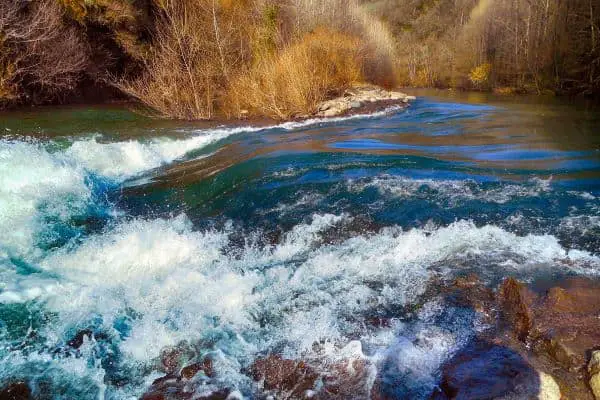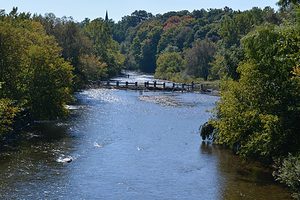Disclosure: Some posts contain affiliate links, which earn us a commission if you make a purchase through them. Positive Fishing © participates in various affiliate networks including the Amazon Services LLC Associates Program.
Spin fishing in fast-moving rivers can raise the hair on the back of some anglers’ necks. The challenge of getting stuck, struggling to get your choice of bait in the ideal position, and landing fish can deter even some of the most dedicated anglers. Thankfully, that leaves more fish for those willing to put in the extra effort.
In this article, let’s learn:
- Where are the fish in fast currents?
- What are the best ways to fish fast currents?
- What to avoid when fishing in fast currents?
- Choosing the ideal spin fishing gear for fast-moving water
Where Are The Fish In Fast Currents?
We all have had dozens of days on the water where you can’t seem to do anything to find fish. Whether it’s a river you’ve fished 100 times or the first time, there are always going to be days when nothing is working. It’s important to be able to discern the best locations where the fish live or if it’s truly an off day.
You don’t have to look that hard to find fish in white and intimidating water. The thing you have going for you is that fish can only live in a few places. They don’t want to fight a current if they don’t have to. They’ll do whatever they can to find slow-moving water that doesn’t move them around.
The first thing to do when you approach fast-moving water is to look closely for any part that’s slack or slower than the main current. You can almost guarantee that it will have fish stacked up in it. These areas can be large and often in wider portions of the river. It may feel strange, but you’ll likely have to fish right along in front of you where the water is slow.
Tip: The water area close to the bank or shore is called “the margins” by many seasoned anglers.
Another area to look at is behind large rocks or trees. These cause breaks in the water and another spot for fish to stay while they wait for food. They’ll wait and see food move by the slack water, dart out into the current, and grab it. It’s also not uncommon for food to get sucked down in the slack water, making it easier for fish to feed.
The final thing to do in fast-moving water is fish in the deeper areas. If you cannot find slack water anywhere, go to the bottom of the water column. It’s going to take time to get your weight figured out, but once you do, you’ll find fish.
The current is much less severe at the bottom of the river, so if fish can’t find anywhere else to go, that’s where the fish are likely to be.
Best Ways To Fish In The Fast Current?

Fishing fast current with a spinning rod is no easy task. If you’ve done it before, you understand how lines get easily tangled and lures often get stuck. There are ways, however, that you can get to the fish without too much trouble.
The first thing to do is not try to make a miracle cast. Keep it simple when you start to fish the water in front of you. The more current you have between you and your lure, the more trouble you will have. Get as close to your preferred fishable water area as possible and make short casts first. You’ll have more time in the best possible area and waste less time trying to get your bait or lure in the perfect place.
The next thing to understand is the depth at which you’re fishing. Too many anglers lose out on dozens of fish because they can’t get their lure to the proper part of the water column. There’s a fine line between not enough weight and too much weight. You don’t want your lure free-flowing in the current, but you also don’t want it stuck on the bottom.
The ideal amount of weight will have your bait bounce along the bottom. As long as it’s moving, you’re in good shape.
Another thing to focus on is giving your bait or lure more time to get to the proper depth. You’ll likely have to cast much farther upstream than you would in a river with a normal flow rate. Give your bait time to get in the proper place! The strike zone can often be a few yards, so you don’t want to lose out on any of that precious area.
Don’t be afraid to switch up your bait. Since so much food flows downstream, fish have few choices.
If your bait isn’t working after a few casts, consider four alternatives:
First, make sure your bait is at the proper depth! As long as it is, you can switch around your bait.
Adjust your fishing depth, go deeper, and then shallower till you find the right sweet spot where the fish are.
Second, cast to a different distance, go short casts and see if there is any fish nearer to you. Then go along to the far bank if possible, or under trees and near weed beds.
Third, Try holding back your bait, so it comes up in the water and then sinks back down again.
Fourth, try different baits and lures.
Eventually, if the fish are feeding, you will find them!
What To Avoid When Fishing A Fast Current?

river for the best chances to catch more fish.
Do your best to avoid impatience. In fast water, you don’t have the opportunity to sit and wait for something to take your bait. You’ll have to make numerous casts to get your bait in the right place, work different parts of the water, and fish in difficult conditions.
Give yourself time to learn and understand the water!
Next, avoid taking on too much water at a time. If you find a 10-yard section of slack water, continue to fish it as long as possible until you know no fish in it will eat your bait. Fish often need a perfect bait presentation; it takes time to accomplish this when the water moves extremely fast. It’s an effort of patience, but you’ll be rewarded.
Tip: The fish will likely get spooked when you first arrive at the water. Let your bait or lure flow as far down the river as possible away from you.
Ideal Spin Fishing Gear For Fast Moving Water
Perhaps the most important part of your gear setup is your line. You’ll want to use a line that’s going to sink.
Monofilament line is a favorite choice for most spin anglers, but it has an extremely slow sink rate. Your bait and lure may not get to the bottom of the water column as fast as you need unless you add weights to the line.
If you use a fluorocarbon line, you’ll find that it sinks faster and performs better. It’s smooth and won’t wear out as fast as a monofilament line.
The next thing to consider is your rod and reel setup. A 7’ to 9’ foot long rod will work great for throwing lures in search of trout or other fish living in the river. If you’re hoping to float fish or bounce bait along the bottom, you’ll want a 9′ to 13′ foot rod. A medium-light or medium-spinning model will have enough power and weight to land fish. It’ll also work well to make your longer casts.
Many anglers love using ultralight models, but those are usually insufficient for fast currents. A 9’6” light or medium light would be a wonderful option!
Using a fast-action rod instead of a slow action is an excellent option. Fast-action rods are going to work as well in tougher conditions. They’re not as sensitive, but that’s not necessary for fishing in fast-moving water. Using a fast-action rod, you’ll get faster hook sets and be able to make much longer casts.
Choosing the right spinning reel is far easier, as they are more versatile than other reels and can be used for all types of fish. Always pick one that is of good quality and reliable.
Final Thoughts
Don’t make the mistake of passing by white water that may look challenging to fish. Fish are waiting to be caught, but it will take a bit of discipline and creativity to land them.
If you can pull fish out of these conditions, you will be a more versatile angler.
I hope this article was helpful; you can find out more by reading my articles on how to fly fish in fast-moving waters and how to choose the ideal freshwater spinning rod weight and action.
- Wading Belt Essentials: Ensuring Safer Fishing - January 9, 2024
- Fishing For Catfish (Top Tips, Bait, & Gear To Catch The Big 3) - October 20, 2022
- Fishing Line Strength Vs. Diameter Chart: Why Is It Important? - October 12, 2022

